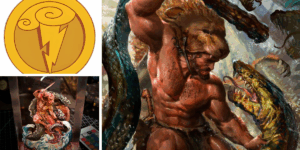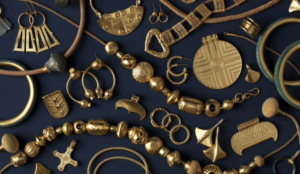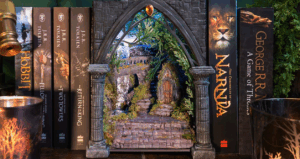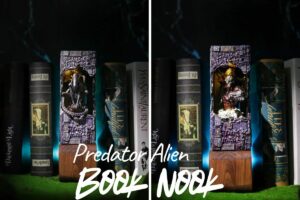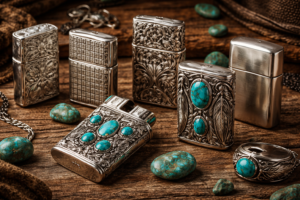In Norse mythology, Loki stands as a figure of boundless complexity—a god of mischief, cunning, and transformation whose essence defies simple representation. Known as the trickster who navigates the blurred lines between chaos and creation, Loki’s identity is woven into ancient runes and symbols that carry profound meaning. From the fiery Kenaz rune to the serpentine imagery of intertwined snakes, these markers reflect Loki’s multifaceted nature. Whether etched in ancient carvings or reimagined in Marvel’s Loki series, the runes associated with Loki—particularly the runes Lokikeyword, Kenaz, and the ouroboric serpents—offer a glimpse into the Norse god’s enigmatic legacy. This article delves into the symbols tied to Loki in Norse mythology rune, exploring their historical roots, cultural significance, and modern interpretations, all while honouring the rich traditions of Nordic lore.
Kenaz: The Loki Rune
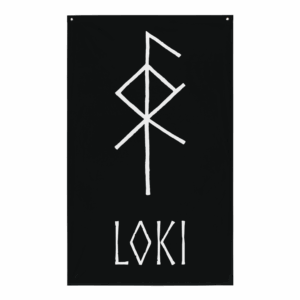
The Kenaz rune (ᚲ), meaning “torch,” is widely regarded as the most iconic Loki rune symbol. Its shape and meaning encapsulate the essence of Loki’s character in Norse mythology. Here’s why Kenaz resonates so deeply:
-
Knowledge and Cunning: Kenaz symbolises creativity, craftiness, and the pursuit of truth. Loki, the shapeshifting strategist, embodies these traits, using his wit to outmanoeuvre gods and mortals alike. Whether aiding the Æsir or sowing discord, his intelligence burns brightly, much like a torch illuminating hidden truths.
-
Destructive Potential: Like fire, Kenaz represents both illumination and danger. Loki’s duality—his ability to create and destroy—mirrors this. His actions spark both innovation (e.g., crafting Thor’s hammer, Mjölnir) and chaos (e.g., orchestrating Baldr’s death).
-
Modern Depictions: In the Marvel Cinematic Universe (MCU), nordic Loki rune symbol Kenaz appears subtly on Loki’s costumes and iconic helmet, reinforcing his association with “controlled chaos.” The rune’s angular form evokes both elegance and unpredictability, perfectly aligning with Loki’s aesthetic.
Kenaz, as a Loki norse rune, is not just a symbol but a narrative of fire’s dual nature—creation and destruction intertwined, much like Loki himself.
>>> Fenrir in Runes: Symbols, Tattoos and Norse Writing
Loki’s Name in Elder Futhark Runes

>>> Nordic Rune for Wolf: Symbols, Meanings & Viking Connections
While the Younger Futhark was used in later Viking Age inscriptions, scholars often reconstruct Loki’s name in the earlier Elder Futhark to explore its linguistic and symbolic roots. A proposed transcription for Loki in Elder Futharkincludes:
-
Laguz (ᛚ): Representing water and intuition, this rune captures Loki’s fluid, adaptable nature as a shapeshifter.
-
Othala (ᛟ): Symbolising heritage and inheritance, it hints at Loki’s complex ties to the Æsir and Jötnar (giants).
-
Kenaz (ᚲ): As discussed, it reflects Loki’s cunning and fiery essence.
-
Isa (ᛁ): Meaning “ice” or stasis, this rune may allude to Loki familiariy with extremes or his eventual binding.
Linguists note ambiguity in the o-rune (loka vs. loko), reflecting the elusive nature of Loki in runes. This complexity underscores Loki’s undefined origins, making his runic representation a subject of scholarly debate and fascination.
Beyond Kenaz: Loki’s Symbolic Arsenal
Loki’s symbolism extends beyond the Loki symbol rune Kenaz, encompassing a broader array of runes and imagery that deepen his mythological significance:
-
The Ouroboric Serpents: Twin snakes biting their tails form a potent Loki norse rune symbol, representing cyclical chaos, duality, and self-destruction. This imagery, often seen as an infinity loop, reflects Loki’s ability to reinvent himself while remaining tethered to his chaotic essence.
-
Hagalaz (ᚺ): Known as the “hailstone” rune, Hagalaz signifies sudden destruction and rebirth. It resonates with Loki’s role in Ragnarök, the apocalyptic cycle of destruction and renewal in Norse mythology, where he both contributes to chaos and paves the way for rebirth.
-
Bound Figure Imagery: Loki’s punishment for Baldr’s death—bound with his son’s entrails beneath a venom-dripping serpent—appears in art and carvings. This imagery underscores themes of consequence and restraint, contrasting Loki’s usual freedom with moments of captivity.
These symbols collectively paint Loki as a figure of paradox, embodying creation, destruction, and the eternal cycle of change.
>>> Norse Rune for Thor: The Power and Meaning of the Thurisaz Rune
Horns, Fire, and Protection: Misconceptions Explained
Loki’s iconography is often misunderstood, particularly in modern media. Let’s clarify some common misconceptions:
-
Horns: In Norse mythology, horns are rarely associated with Loki. When present, they symbolise duality—light and dark, order and chaos. Marvel’s Loki series reimagines them as a Kenaz-inspired crown, later tying Loki to the Horned God archetype, a pagan symbol of nature’s untamed chaos.
-
Element: Loki is intrinsically linked to fire, as seen in the Loki norse mythology rune Kenaz. His fiery nature is unpredictable, transformative, and destructive, aligning with his role as both creator and disruptor.
-
Protection Rune?: No rune explicitly serves as a Loki protection rune. However, the Dagaz rune (ᛞ), meaning “awakening” or “breakthrough,” appears in the Loki series’ Time Variance Authority (TVA) and metaphorically reflects Loki’s journey toward self-liberation and growth.
These clarifications highlight how Loki’s symbols are reinterpreted across cultures and media, blending ancient lore with modern storytelling.
Conclusion
Loki’s runes and symbols—Kenaz, ouroboric serpents, Hagalaz, and bound figure imagery—transcend mere iconography. They encapsulate his journey from mischievous trickster to a complex anti-hero whose story resonates in ancient carvings, Viking lore, and pop culture phenomena like Marvel’s Loki. The runes Loki keyword, particularly Kenaz, serves as a beacon for his duality: a torch of knowledge that can illuminate or burn. As one scholar poignantly notes, “Loki’s runes remind us that chaos and creation are twin flames.” Whether through the fluidity of Laguz or the rebirth implied by Hagalaz, these symbols invite us to embrace Loki’s complexity—a figure who defies categorisation yet remains eternally compelling.
>>> Viking Rune for Odin: Ansuz, Geri and Freki, and the Wisdom of Norse Symbols
People Also Ask
What rune represents Loki?
Kenaz (ᚲ) is the primary rune associated with Loki, symbolising knowledge, craft, and fire.
What is Loki’s symbol?
Loki’s primary symbols are the Kenaz rune and interlaced serpents, representing his chaotic and transformative nature.
What do Loki’s horns symbolise?
Horns, though rare in myth, signify duality (light/dark, order/chaos) and connect Loki to pagan Horned God archetypes.
What element does Loki represent?
Loki embodies fire—creative, unpredictable, and destructive, as reflected in the nordic Loki rune symbol Kenaz.
Symbols for Hercules: The Meaning and Legacy of the Hercules Knot and Its Ancient Origins
Table of ContentsKenaz: The Loki RuneLoki’s Name in Elder Futhark RunesBeyond Kenaz: Loki’s Symbolic ArsenalHorns,
Nov
Authentic Viking Jewelry: A Glimpse into Norse History and Culture
Table of ContentsKenaz: The Loki RuneLoki’s Name in Elder Futhark RunesBeyond Kenaz: Loki’s Symbolic ArsenalHorns,
May
Creating Middle-earth at Home: The Ultimate Guide to the Lord of the Rings Book Nook Insert
Table of ContentsKenaz: The Loki RuneLoki’s Name in Elder Futhark RunesBeyond Kenaz: Loki’s Symbolic ArsenalHorns,
Oct
Predator Alien Book Nook – A Handcrafted Tribute to Sci-Fi Legends
Table of ContentsKenaz: The Loki RuneLoki’s Name in Elder Futhark RunesBeyond Kenaz: Loki’s Symbolic ArsenalHorns,
Oct
Silver Lighter Cover: Meaning, Materials & Why Sterling Silver Bic Lighter Cases Are Timeless
Table of ContentsKenaz: The Loki RuneLoki’s Name in Elder Futhark RunesBeyond Kenaz: Loki’s Symbolic ArsenalHorns,
Dec
London Transport Museum Shop: A Unique Stop for Transport Enthusiasts
Table of ContentsKenaz: The Loki RuneLoki’s Name in Elder Futhark RunesBeyond Kenaz: Loki’s Symbolic ArsenalHorns,
May


